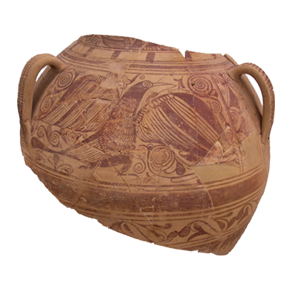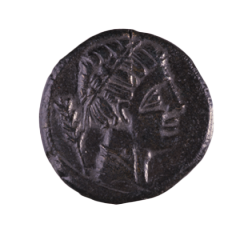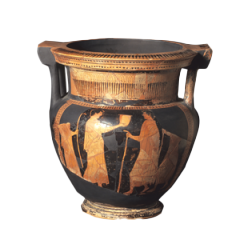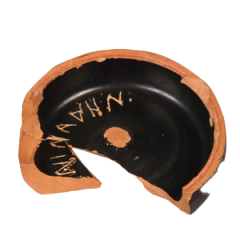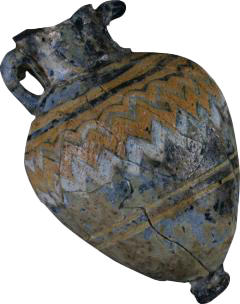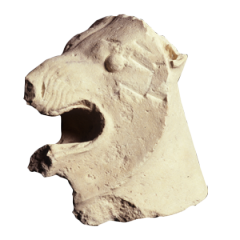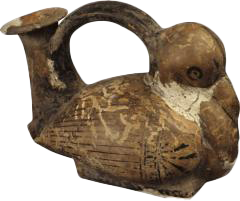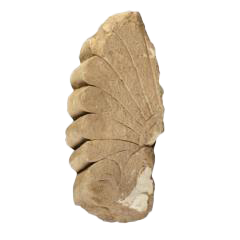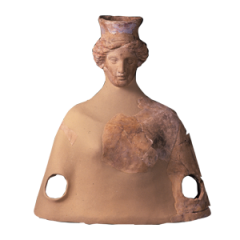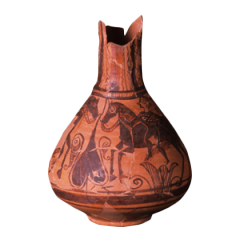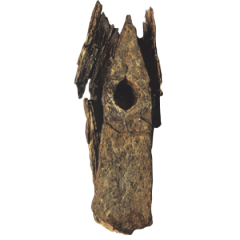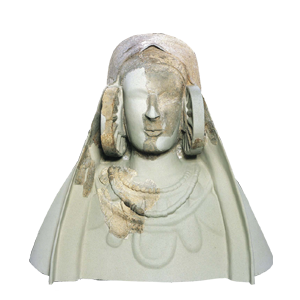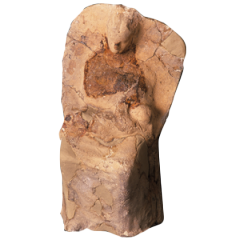
Terracotta female seated with child
DEMETER-LIKE MOTHER-GODDESS Necropolis of La Albufereta (Alicante) Ceramic made with a univalve mould h: 21 cm; w: 11.3 cm; h: 7.5 cm Iberian 4th century BC.
Terracotta depicting a seated female figure. She wears a veil that surrounds her from behind in such a way that the back of the figure appears to be a throne. From this throne, the figure emerges, leaning towards the child she is holding in her arms, whom she has just been breastfeeding. The child, embraced by the mother on her lap, leans her head back while raising her left arm to her breast. The facial features are schematic and not very well defined; the breasts are very pronounced. The posterior area is flat and has a hole in the centre about 3 cm in diameter, perhaps for hanging the piece. In the chest area there is a rust stain that may be due to the contact of this piece with another metal one in the tomb where it was deposited. The throne follows Hellenistic models but with a local interpretation. It has traces of white slip.
This terracotta was found in the "Great Burial" (L-127-A), a tumulus with several burials. The material found includes a series of terracottas with clear Punic overtones. Maternal female figures holding a child in their arms, or curotrophs, are associated throughout the Mediterranean with nurturing divinities such as Demeter, goddess of the Greek pantheon, protector of cultivated land and wheat.
C.S.: 3710
LAFUENTE VIDAL, J., 1934.
RUBIO GOMIS, F., 1986.
LLOBREGAT, E.A., 1972.
MARÍN CEBALLOS, M.C., 1987.
Outstanding pieces in the Iberian Hall
- TINAJA CON DECORACIÓN
ESTILO ELCHE-ARCHENA
Tossal de la Cala (Finestrat).
Cerámica
h: 39 cm; a: 46 cm; e: 30 cm
Iberian
Siglos II-I a.C. - ................................................. Bronze ace from the Iberian mint of Saiti (Xàtiva, Valencia). Type Vives 20-2.
- ................................................. Necropolis of El Cabezo Lucero (Guardamar del Segura) Ceramic h: 34'5cm; w: 29'5 cm Iberian 460-450 BC.
- ................................................. Illeta dels Banyets (El Campello) Ceramic h: 11.2 cm; w: 11.2 cm; d: 2.9 cm Iberian. 380-325 BC.
- ................................................. Necropolis of Cabezo Lucero (Guardamar del Segura) Vitreous paste h: 6.5 cm; w: 4.1 cm: 4'1 cm Ancient Iberian Late 5th century BC.
- ................................................. Necropolis of Cabezo Lucero (Guardamar del Segura, Alicante) Limestone h: 27.5 cm; w: 19 cm; d: 23 cm Iberian Second half of the 5th century - beginning of the 4th century BC.
- ................................................. Necropolis of Cabezo Lucero (Guardamar del Segura)
- ................................................. Necropolis of Cabezo Lucero (Guardamar del Segura) Limestone h: 18.5 cm; w: 8.5 cm; d: 5.3 cm Ancient Iberian-Pliocene Second half of the 5th century-early 4th century BC.
- ................................................. DEMETER-LIKE MOTHER-GODDESS Necropolis of La Albufereta (Alicante) Ceramic made with a univalve mould h: 21 cm; w: 11.3 cm; h: 7.5 cm Iberian 4th century BC.
- Terracotta bust ................................................. Necropolis of La Albufereta (Alicante) Terracotta h: 40 cm; w: 37 cm; d: 21.5 cm Iberian 4th-3rd century BC: 37 cm; w: 21'5 cm Iberian 4th-3rd century BC.
- ................................................. Tossal de Manises (Alicante) Ceramic h: 31.5 cm; w: 21.4 cm Iberian Late 3rd century BC.
- ............................................. La Escuera (San Fulgencio) Iron h: 30 cm; w: 11.4 cm; h: 13.8 cm Iberian 3rd century BC.
- ................................................. Necropolis of Cabezo Lucero (Guardamar del Segura, Alicante) Sandstone) Sandstone h: 49 cm; w: 54 cm; d: 33 cm Iberian Late 5th century BC, early 4th century BC.

